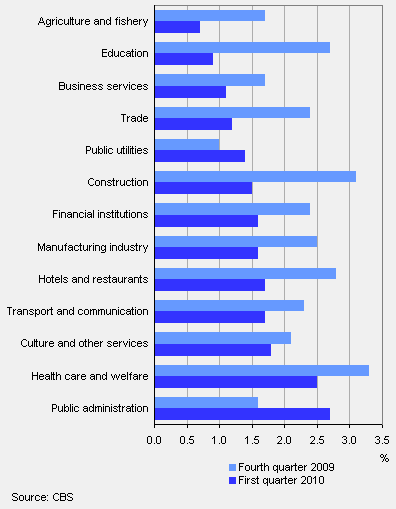Changes on the job market manifest in more modest increase CAO wages

In the first quarter of 2010, collectively negotiated (CAO) wages were 1.6 percent higher than one year previously. Since early 2009, the increase in CAO wages was reduced by more than half. The reduction is caused by the tough job market and the declining inflation rate.
CAO wage increase the same as three years ago
The 1.6 percent increase in CAO wages is in the same order of magnitude as the increase at the beginning of 2007, but considerably smaller than twelve months ago. Early 2009, collectively negotiated wages still rose by 3.6 percent. The preliminary results over the first quarter of 2010 are based upon three quarters of collective labour agreements.
Collectively negotiated wages and contractual wage costs

Smallest wage increase in sector agriculture and fishery, highest in public administration
The lowest CAO wage increase was recorded in the sector agriculture and fishery. In the sectors education, trade and construction, the increase slowed down considerably.
With 2.7 percent, the most substantial CAO wage increase was recorded in the sector public administration. This is chiefly because the end-of-year bonus over 2010 in the sector central government has been raised to the level of a thirteenth-month bonus. These agreements were already concluded in 2007. At the various other levels of government, i.e. municipalities, provinces and water boards, no new agreements were negotiated. As a result, nearly half of collective labour agreements in public administration have expired, making the effect of the end-of-year bonus disproportionately large. If special bonuses are not taken into account, CAO wages in public administration increased by 1.5 percent.
CAO wage increase by sector

Contractual wage costs 1.9 percent up
In the first quarter of 2010, contractual wage costs were raised by 1.9 percent. The increase is 0.3 percentage points higher than the CAO wage increase. This is predominantly caused by higher employer’s contributions into reduced payment schemes and health care costs.
Increase contractual wage costs by CAO sector

Taking all CAO sectors into account, wage costs increased most (2.8 percent) in the subsidised sector in the first quarter. The main reason is the growth in collectively negotiated wages, which is partly caused by the introduction of the personal life stage-related budget in a number of collective labour agreements. Working hours are reduced and because monthly wages remain the same, hourly wages will increase.
Monique Hartog